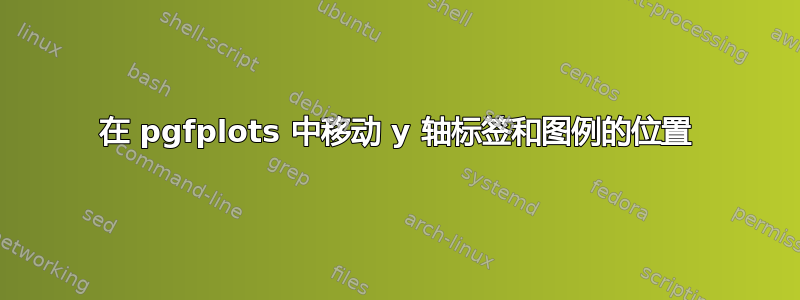
我想将其中一个 y 标签移动到右侧的第二组图,并将图例移动到图的中心,如下所示:
以下是代码:
\documentclass[11pt]{book}
\usepackage[%
,top=3cm
,bottom=3cm
,left=3.2cm
,right=3.2cm
,headsep=10pt
,a4paper
]{geometry}
\usepackage{lipsum}
\usepackage{pgfplots,pgfplotstable, booktabs}
\usetikzlibrary{pgfplots.groupplots, matrix}
\usepgfplotslibrary{groupplots}
\pgfplotsset{%
compat=1.12,
minor grid style={dashed,red},
major grid style={dotted,green!50!black},
select coords between index/.style 2 args={
x filter/.code={
\ifnum\coordindex<#1\def\pgfmathresult{}\fi
\ifnum\coordindex>#2\def\pgfmathresult{}\fi
}
}}
\usepackage{subfig}
\captionsetup[subfigure]{labelfont={it,bf},textfont={it,bf},labelformat=parens,labelsep=space}
\usepackage{siunitx}
\usepackage{listings}
\usepackage{filecontents}
\begin{filecontents*}{array.csv}
A B C D
1 -10 -15 -20
2 -20 -20 -25
3 -30 -25 -30
4 -40 -30 -35
5 -50 -35 -40
6 -60 -40 -45
7 -70 -45 -50
8 -80 -50 -55
9 -90 -55 -60
10 -100 -60 -65
11 -110 -65 -70
12 -120 -70 -75
13 -130 -75 -80
14 -140 -80 -85
15 -150 -85 -90
16 -160 -90 -95
17 -170 -95 -100
18 -180 -100 -105
19 -190 -105 -110
20 -200 -110 -115
21 -210 -115 -120
22 -220 -120 -125
23 -230 -125 -130
24 -240 -130 -135
25 -250 -135 -140
26 -260 -140 -145
27 -270 -145 -150
28 -280 -150 -155
29 -290 -155 -160
30 -300 -160 -165
\end{filecontents*}
\begin{document}
\begin{figure}
\centering
\begin{tikzpicture}
\setcaptionsubtype
\begin{groupplot}[%
,group style={%
,group name=my plots
,group size=2 by 2
,vertical sep=2cm,
,horizontal sep = 2cm,
,ylabels at=edge left
}
,width=7cm
,height=6cm
,try min ticks=5
,xlabel={\bfseries{\emph{Time in Secs}}}
,grid=both
,every major grid/.style={gray, opacity=0.5}
]
\nextgroupplot%
\addplot[select coords between index={0}{9},mark=*,red,mark options={scale=.65}]table[x index=0,y index=1,col sep=space] {array.csv};\label{plots:InstA}
\addplot[select coords between index={0}{9},mark=*,blue,mark options={scale=.65}]table[x index=0,y index=2,col sep=space] {array.csv};\label{plots:InstB}
\addplot[select coords between index={0}{9},cyan]table[x index=0,y index=3,col sep=space] {array.csv};\label{plots:InstC}
\coordinate (top) at (rel axis cs:0,1);
\nextgroupplot%
\addplot[select coords between index={10}{19},mark=*,red,mark options={scale=.65}]table[x index=0,y index=1,col sep=space] {array.csv};
\addplot[select coords between index={10}{19},mark=*,blue,mark options={scale=.65}]table[x index=0,y index=2,col sep=space] {array.csv};
\addplot[select coords between index={10}{19},cyan]table[x index=0,y index=3,col sep=space] {array.csv};
\coordinate (top2) at (rel axis cs:0,1);
\nextgroupplot%
\addplot[select coords between index={20}{24},mark=*,red,mark options={scale=.65}]table[x index=0,y index=1,col sep=space] {array.csv};
\addplot[select coords between index={20}{24},mark=*,blue,mark options={scale=.65}]table[x index=0,y index=2,col sep=space] {array.csv};
\addplot[select coords between index={20}{24},cyan]table[x index=0,y index=3,col sep=space] {array.csv};
\coordinate (bot) at (rel axis cs:1,0);
\nextgroupplot%
\addplot[select coords between index={25}{29},mark=*,red,mark options={scale=.65}]table[x index=0,y index=1,col sep=space] {array.csv};
\addplot[select coords between index={25}{29},mark=*,blue,mark options={scale=.65}]table[x index=0,y index=2,col sep=space] {array.csv};
\addplot[select coords between index={25}{29},cyan]table[x index=0,y index=3,col sep=space] {array.csv};
\coordinate (bot2) at (rel axis cs:2,0);
\end{groupplot}
\path (top-|current bounding box.west)--
node[anchor=south,rotate=90] {\large{\bf{Testing of Parameters}}}
(bot-|current bounding box.west);
\path (top2-|current bounding box.west)--
node[anchor=south,rotate=90] {\large{\bf{Testing of Parameters}}}
(bot2-|current bounding box.west);
% legend
\path (top|-current bounding box.south)--
coordinate(legendpos)
(bot|-current bounding box.south);
\matrix[
matrix of nodes,
anchor=south,
draw,
inner sep=0.2em,
draw
]at([yshift=-3ex]legendpos)
{
\ref{plots:InstA}& \footnotesize{InstA}&[5pt]
\ref{plots:InstB}& \footnotesize{InstB}&[5pt]
\ref{plots:InstC}& \footnotesize{InstC}&[5pt]\\};
\node[text width=.5\linewidth,align=center,anchor=south] at (my plots c1r1.north) {\caption[]{Test 1\label{subplot:one}}};
\node[text width=.5\linewidth,align=center,anchor=south] at (my plots c2r1.north) {\caption[]{Test 2\label{subplot:two}}};
\node[text width=.5\linewidth,align=center,anchor=south] at (my plots c1r2.north) {\caption[]{Test 3\label{subplot:three}}};
\node[text width=.5\linewidth,align=center,anchor=south] at (my plots c2r2.north) {\caption[]{Test 4\label{subplot:four}}};
\end{tikzpicture}
\caption[]{Comparison of different tests.}\label{abserror}
\end{figure}
\end{document}
答案1
您已将组图命名为,group name=my plots因此您可以使用类似坐标,my plots c1r1.north east而不必定义新坐标。这样,定位标签和图例就更容易了。
\path [nodes={anchor=south,rotate=90,font=\large\bfseries,midway}]
(my plots c1r1.outer north west)--(my plots c1r2.outer south west)
node {Testing of Parameters 1}
(my plots c2r1.outer north west)--(my plots c2r2.outer south west)
node {Testing of Parameters 2}
;
% legend
\path (my plots c1r1.west|-current bounding box.south)--
coordinate(legendpos)
(my plots c2r2.east|-current bounding box.south);
\matrix[
matrix of nodes,
anchor=south,
draw,
inner sep=0.2em,
draw
]at([yshift=-4ex]legendpos)
{
\ref{plots:InstA}& \footnotesize{InstA}&[5pt]
\ref{plots:InstB}& \footnotesize{InstB}&[5pt]
\ref{plots:InstC}& \footnotesize{InstC}&[5pt]\\};
代码:
\begin{filecontents*}{array.csv}
A B C D
1 -10 -15 -20
2 -20 -20 -25
3 -30 -25 -30
4 -40 -30 -35
5 -50 -35 -40
6 -60 -40 -45
7 -70 -45 -50
8 -80 -50 -55
9 -90 -55 -60
10 -100 -60 -65
11 -110 -65 -70
12 -120 -70 -75
13 -130 -75 -80
14 -140 -80 -85
15 -150 -85 -90
16 -160 -90 -95
17 -170 -95 -100
18 -180 -100 -105
19 -190 -105 -110
20 -200 -110 -115
21 -210 -115 -120
22 -220 -120 -125
23 -230 -125 -130
24 -240 -130 -135
25 -250 -135 -140
26 -260 -140 -145
27 -270 -145 -150
28 -280 -150 -155
29 -290 -155 -160
30 -300 -160 -165
\end{filecontents*}
\documentclass[11pt]{book}
\usepackage[%
,top=3cm
,bottom=3cm
,left=3.2cm
,right=3.2cm
,headsep=10pt
,a4paper
]{geometry}
\usepackage{lipsum}
\usepackage{pgfplots,pgfplotstable, booktabs}
\usetikzlibrary{pgfplots.groupplots, matrix}
\usepgfplotslibrary{groupplots}
\pgfplotsset{%
compat=1.12,
minor grid style={dashed,red},
major grid style={dotted,green!50!black},
select coords between index/.style 2 args={
x filter/.code={
\ifnum\coordindex<#1\def\pgfmathresult{}\fi
\ifnum\coordindex>#2\def\pgfmathresult{}\fi
}
}}
\usepackage{subfig}
\captionsetup[subfigure]{labelfont={it,bf},textfont={it,bf},labelformat=parens,labelsep=space}
\begin{document}
\begin{figure}
\centering
\begin{tikzpicture}
\setcaptionsubtype
\begin{groupplot}[%
,group style={%
,group name=my plots
,group size=2 by 2
,vertical sep=2cm,
,horizontal sep = 2cm,
,ylabels at=edge left
}
,width=7cm
,height=6cm
,try min ticks=5
,xlabel={\bfseries{\emph{Time in Secs}}}
,grid=both
,every major grid/.style={gray, opacity=0.5}
]
\nextgroupplot%
\addplot[select coords between index={0}{9},mark=*,red,mark options={scale=.65}]table[x index=0,y index=1,col sep=space] {array.csv};\label{plots:InstA}
\addplot[select coords between index={0}{9},mark=*,blue,mark options={scale=.65}]table[x index=0,y index=2,col sep=space] {array.csv};\label{plots:InstB}
\addplot[select coords between index={0}{9},cyan]table[x index=0,y index=3,col sep=space] {array.csv};\label{plots:InstC}
\nextgroupplot%
\addplot[select coords between index={10}{19},mark=*,red,mark options={scale=.65}]table[x index=0,y index=1,col sep=space] {array.csv};
\addplot[select coords between index={10}{19},mark=*,blue,mark options={scale=.65}]table[x index=0,y index=2,col sep=space] {array.csv};
\addplot[select coords between index={10}{19},cyan]table[x index=0,y index=3,col sep=space] {array.csv};
\nextgroupplot%
\addplot[select coords between index={20}{24},mark=*,red,mark options={scale=.65}]table[x index=0,y index=1,col sep=space] {array.csv};
\addplot[select coords between index={20}{24},mark=*,blue,mark options={scale=.65}]table[x index=0,y index=2,col sep=space] {array.csv};
\addplot[select coords between index={20}{24},cyan]table[x index=0,y index=3,col sep=space] {array.csv};
\nextgroupplot%
\addplot[select coords between index={25}{29},mark=*,red,mark options={scale=.65}]table[x index=0,y index=1,col sep=space] {array.csv};
\addplot[select coords between index={25}{29},mark=*,blue,mark options={scale=.65}]table[x index=0,y index=2,col sep=space] {array.csv};
\addplot[select coords between index={25}{29},cyan]table[x index=0,y index=3,col sep=space] {array.csv};
\end{groupplot}
\path [nodes={anchor=south,rotate=90,font=\large\bfseries,midway}]
(my plots c1r1.outer north west)--(my plots c1r2.outer south west)
node {Testing of Parameters 1}
(my plots c2r1.outer north west)--(my plots c2r2.outer south west)
node {Testing of Parameters 2}
;
% legend
\path (my plots c1r1.west|-current bounding box.south)--
coordinate(legendpos)
(my plots c2r2.east|-current bounding box.south);
\matrix[
matrix of nodes,
anchor=south,
draw,
inner sep=0.2em,
draw
]at([yshift=-4ex]legendpos)
{
\ref{plots:InstA}& \footnotesize{InstA}&[5pt]
\ref{plots:InstB}& \footnotesize{InstB}&[5pt]
\ref{plots:InstC}& \footnotesize{InstC}&[5pt]\\};
\node[text width=.5\linewidth,align=center,anchor=south] at (my plots c1r1.north) {\caption[]{Test 1\label{subplot:one}}};
\node[text width=.5\linewidth,align=center,anchor=south] at (my plots c2r1.north) {\caption[]{Test 2\label{subplot:two}}};
\node[text width=.5\linewidth,align=center,anchor=south] at (my plots c1r2.north) {\caption[]{Test 3\label{subplot:three}}};
\node[text width=.5\linewidth,align=center,anchor=south] at (my plots c2r2.north) {\caption[]{Test 4\label{subplot:four}}};
\end{tikzpicture}
\caption[]{Comparison of different tests.}\label{abserror}
\end{figure}
\end{document}




